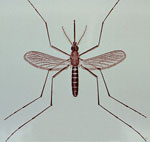Volume 27, Number 8—August 2021
Etymologia
Etymologia: Culex quinquefasciatus
Culex quinquefasciatus [′kyo͞o leks ′kwinkwə fa she ′ah tus]
In 1823, the American entomologist Thomas Say described Culex (Latin for “gnat”) quinquefasciatus, which he collected along the Mississippi River. Originally written as “C. 5-fasciatus,” the name refers to 5 (“quinque”) black, broad, transverse bands (“fasciatus” or “fasciae”) on the mosquito’s dorsal abdomen (Figure). The name remains despite later revelations of more than 5 fasciae, thanks to improved microscopy. Although quinquefasciatus is the official scientific name, there are at least 5 synonymous names for this species.
Say described this species as “exceedingly numerous and troublesome.” “Quinx” are among the world’s most abundant peridomestic mosquitoes, earning the nickname “southern house mosquito.” Cx. quinquefasciatus is found throughout subtropical and tropical areas worldwide, except for exceedingly dry or cold regions. This mosquito is a principal vector of many pathogens, transmitting the phlebovirus Rift Valley fever virus and the 2 flaviviruses St. Louis encephalitis virus and West Nile virus, in addition to filarial worms and avian malarial parasites.
References
- Belkin J. Quinquefasciatus or Fatigans for the tropical (Southern) house mosquito (Diptera: Culicidae). Proc Entomol Soc Wash. 1977;79:45–52.
- Farajollahi A, Fonseca DM, Kramer LD, Marm Kilpatrick A. “Bird biting” mosquitoes and human disease: a review of the role of Culex pipiens complex mosquitoes in epidemiology. Infect Genet Evol. 2011;11:1577–85. DOIPubMedGoogle Scholar
- Harrison BA, Byrd BD, Sither CB, Whitt PB. The Mosquitoes of the Mid-Atlantic Region: An Identification Guide. Cullowhee (NC): Western Carolina University; 2016.
- Say T. Descriptions of dipterous insects of the United States. Journal of the Academy of Natural Sciences. 1823;3:9–54.
- University of Florida, Department of Entomology and Nematology. Featured creatures. [cited 2021 Mar 3]. https://entnemdept.ufl.edu/creatures/aquatic/southern_house_mosquito.htm
Figure
Cite This ArticleOriginal Publication Date: July 01, 2021
Related Links
Table of Contents – Volume 27, Number 8—August 2021
| EID Search Options |
|---|
|
|
|
|
|
|

Please use the form below to submit correspondence to the authors or contact them at the following address:
Sarah Anne J. Guagliardo, Centers for Disease Control and Prevention, 1600 Clifton Rd NE, Atlanta, GA 30327-4027, USA
Top